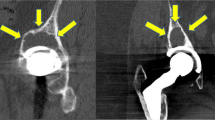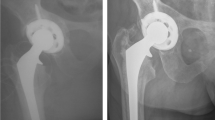Abstract
Between April 1984 and December 1987 a Müller acetabular reinforcement ring was employed in 98 revision cases (94 patients). Twenty-two patients died before follow-up evaluation. Forty-seven (66%) of the remaining 72 patients (49 of 75 hips) were examined after a mean of 6.4 years (range 5–9 years). Excluding those who died, the postoperative outcome of 69 patients is known. Migration was measured according to Sutherland by means of a digitising table. Cup position was determined by a new angle (beta) between the sacroiliacal line and a reference line. The reference line connects the centre of the femoral head with the intersection between the sacroiliacal and the obturator lines. Aseptic and septic loosening required revision surgery in 2 cases each (4%). The postoperative beta angle showed a high correlation with migration (P = 0.001) as well as with radiolucencies (P = 0.001). In cases which required further revision, beta amounted to 44 deg (craniolateral position), and in stable cases up to 60 deg. A lateral and cranial position of a Müller acetabular reinforcement ring leads to high loosening rates. The beta angle accurately describes cup position, and its postoperative value is highly predictive for loosening.
Similar content being viewed by others
References
Aebi M, Richner, Ganz R (1989) Langzeitergebnisse der pri, mären Hüfttotalendoprothese mit Acetabulumstützring. Orthopäde 18:504–510
Azuma T, Yasuda H, Okagaki K, Sakai K (1994) Compressed allograft chips for acetabular reconstruction in revision hip arthroplasty. J Bone Joint Surg [Br] 76:740–744
Bauer R, Kerschbaumer F, Poisel S (1990) Operative Zugangswege in Orthopädie und Traumatologie. Thieme, Stuttgart
Brooker A, Bowermann J, Robinson R, Riley L (1973) Ectopic ossification following total hip replacement. J Bone Joint Surg [Am] 55:1629–1632
DeLee JG, Chamley J (1976) Radiological demarcation of cemented sockets in total hip replacement. Clin Orthop 121:20–32
Fuchs MD, Salvati EA, Wilson PD, Sculco TP, Pellicci PM (1988) Results of acetabular revision with newer cement techniques. Orthop Clin North Am 19:649–655
Gossens M, Van Nieuwenhuyse W, Claessens H (1988) Total hip replacement with Müller acetabular reinforcement ring in rheumatic disease. Acta Orthop Belg 54:137–141
Gustke KA, Grossman RM (1987) Acetabular reconstruction in primary and revision total hip arthroplasty. Tech Orthop 2:65–76
Haentjes P, Handelberg F, Casteleyn P, Opdecam P (1986) Experience with the Müller acetabular reinforcement ring in conventional and in revision arthroplasty of the hip. Acta Orthop Belg 52:344–347
Haentjes P, Boeck H, Handelberg F, Casteleyn P, Opdecam P (1993) Cemented acetabular reconstruction with the Müller support ring. Clin Orthop 290:225–235
Hooten JP Jr, Engh CA Jr, Engh CA (1994) Failure of structural acetabular allografts in cementless revision hip arthroplasty. J Bone Joint Surg [Br] 76:419–422
Johnston RC, Fitzgerald RH, Harris WH, Müller ME, Sledge CB (1990) Clinical and radiographic evaluation of total hip replacement. J Bone Joint Surg [Am] 72:161–168
Kaplan EL, Meier P (1958) Nonparametric estimation from incomplete observations. J Am Stat Assoc 53:457
Kavanagh BF, Illstrup DM, Fitzgerald RH Jr (1985) Revision total hip arthroplasty. J Bone Joint Surg [Am] 67:517–526
Korovesis P, Spastris P, Sdougos G, Salonikides P, Christodoulou G, Katsoudas G (1992) Acetabular roof reinforcement rings. Clin Orthop 283:149–155
Krismer M, Bauer R, Tschupik J, Mayrhofer P (1995) EBRA: a method to measure migration of acetabular components. J Biomech 28:1225–1236
Lachiewicz PF, Hussamy OD (1994) Revision of the acetabulum without cement with use of the Harris-Galante porouscoated implant. J Bone Joint Sung [Am] 76:1834–1839
Mayer G, Hartseil K (1986) Acetabular reinforcement in total hip replacement. Arch Orthop Trauma Surg 105:227–231
Morscher E (1987) Erfahrungen, Anforderungen und Entwicklungen von zementfreien Hüftendoprothesen. Orthopäde 16:185–196
Müller ME (1981) The hip: proceedings of the 9th Open Scientific Meeting of the Hip Society. Mosby, St. Louis, pp 46–56
Rosson J, Schatzker J (1992) The use of reinforcement rings to reconstruct deficient acetabular. J Bone Joint Surg [Br] 74:716–720
Schatzker J, Glynn MK, Ritter D (1984) A preliminary review of the Müller acetabular and Burch Schneider antiprotrusio support rings. Arch Orthop Trauma Surg 103:5–12
Schatzker J, Hastings DE, McBroom J (1994) Acetabular reinforcement in total hip arthroplasty. Arch Orthop Trauma Surg 113:135–141
Schneider R (1987) Die Totalprothese der Hüfte. (Aktuelle Probleme in Chirurgie und Orthopädie 24). Verlag Hans Huber, Bern
Schutzer SF, Harris WH (1994) High placement of porous-coated acetabular components in complex total hip arthroplasty. J Arthroplasty 9:359–367
Sommacal R, Ochsner PE, Ott E (1995) Results of use of the acetabular roof reinforcement ring in primary procedures and in revision arthroplasty: EBRA migration analysis of a 5-year follow-up. J Bone Joint Surg [Br] 77 (Suppl 11):163
Sutherland CJ, Wilde AH, Borden LS, Marks KE (1982) A tenyear follow-up of one hundred consecutive Müller curved stem total hip-replacement arthroplasties. J Bone Joint Surg [Am] 64:970–981
Author information
Authors and Affiliations
Rights and permissions
About this article
Cite this article
Stöckl, B., Beerkotte, J., Krismer, M. et al. Results of the Müller acetabular reinforcement ring in revision arthroplasty. Arch Orthop Trauma Surg 116, 55–59 (1997). https://doi.org/10.1007/BF00434102
Received:
Issue Date:
DOI: https://doi.org/10.1007/BF00434102




